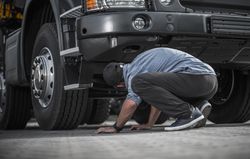
If you’re training to get your commercial driver’s license (CDL) or you’re a new truck driver, it’s important to understand how roadside inspections work. Failing one can put you behind schedule and create complications when you're working. Here’s an overview of what happens during an inspection, what the different types are, and how to ensure you pass.
What Is a Roadside Inspection?
Roadside inspections are examinations of commercial vehicles conducted by Motor Carrier Safety Assistance Program (MCSAP) or Department of Transportation (DOT) inspectors. Their goal is to make sure that drivers are complying with the Federal Motor Carrier Safety Regulations (FMCSRs). If there are violations, the operator will be issued an out-of-service order, which means they can’t drive until the violations are corrected.
Which Vehicles Get Inspected?
 The DOT will do annual inspections of commercial vehicles that weigh over five tons. There are around four million inspections done across the United States each year, according to the Federal Motor Carrier Safety Administration (FMCSA). This ensures that truckers are held to regulatory standards, keeping the roads safer.
The DOT will do annual inspections of commercial vehicles that weigh over five tons. There are around four million inspections done across the United States each year, according to the Federal Motor Carrier Safety Administration (FMCSA). This ensures that truckers are held to regulatory standards, keeping the roads safer.
What Are the Different Levels of Inspection?
While truck drivers may have had an inspection before, many don’t realize that there are six levels of DOT inspections. Each level has different requirements, and it’s crucial to be prepared for any type. Here’s what you need to know.
Level I: North American Standard Inspection
This type of inspection is thorough and comprehensive, covering both the vehicle and the driver. An inspector will check your documents and search for drugs, hazardous materials, and alcohol. To ensure that you pass, have all the necessary documents, including your commercial driver’s license, Driver and Vehicle Inspection Report, and your driver's daily log and Hours of Service.
Additionally, they’ll inspect many of your vehicle parts, so make sure they’re in good shape. For example, they’ll examine the frame, steering mechanisms, wheels, windshield wipers, seatbelt, turn signals, and brake system.
Level II: Walk-Around Driver/Vehicle Inspection
This type of inspection is similar to the Level I inspection. However, the inspector won’t examine any parts or items that are under the truck. This level is less comprehensive, but it’s still crucial to have your documents and vehicle parts in order.
Level III: Driver-Only Inspection
A Level III inspection will only focus on the truck driver’s credentials. For example, they’ll inspect the medical card and waiver, driver’s license, Vehicle Inspection Report, HOS documents, seat belts, Skill Performance Evaluation (SPE) certificate, and Record of Duty Status (RODS).
Level IV: Special Inspections
This is a one-time examination that covers a specific feature or vehicle part. It’ll usually focus on a trend that the DOT wants to research. For example, they may inspect a common violation from the previous year to see if truck drivers are making improvements.
Level V: Vehicle-Only Inspection
The Level V inspection is similar to a Level I, but the driver can’t be present. It’s usually conducted after an accident or arrest, so the trucker will be away from the vehicle, either in the hospital or in police custody.
Level VI: Enhanced NAS Inspection for Radioactive Shipments
While this type of inspection is rare, it’s worth preparing for. It applies to any truck carrying radioactive materials. The examination will include everything in Level I, as well as an inspection of radiological shipments and requirements.
How to Prepare for an Inspection
 Regularly check the vehicle tire pressure and tread, as well as the hoses and engine. Although poor cleanliness won’t necessarily lead to failing the inspection, it’s still worth washing the windows and tires, throwing out any trash in the cab, and organizing the paperwork. Showing the inspector that you care about the truck demonstrates that you’re detail-oriented, responsible, and careful. It also ensures all the parts are visible while they conduct the inspection. Additionally, watch for obvious offenses, like a broken headlight or chipped windshield.
Regularly check the vehicle tire pressure and tread, as well as the hoses and engine. Although poor cleanliness won’t necessarily lead to failing the inspection, it’s still worth washing the windows and tires, throwing out any trash in the cab, and organizing the paperwork. Showing the inspector that you care about the truck demonstrates that you’re detail-oriented, responsible, and careful. It also ensures all the parts are visible while they conduct the inspection. Additionally, watch for obvious offenses, like a broken headlight or chipped windshield.
To ensure that you stay up-to-date on maintenance, set up a schedule based on engine hours and mileage. Use your phone to create alerts. Being proactive about maintenance will ensure that the inspector finds everything in tip-top shape.
Also, store any relevant documents in the truck, and make photocopies in case you lose one. For example, you’ll need your driver’s license, vehicle insurance and registration, Record of Duty status, annual inspection records, permit credentials, and IFTA card. Keep the inspections top-of-mind by setting a quarterly reminder to prepare and get the truck ready.
Before leaving on a trip, perform your own inspection based on the Driver’s Vehicle Inspection Report (DVIR). Make sure you check off the boxes, including examining the brakes, horn, mirrors, lights, clutch, battery, and defrost. Additionally, check for oil and exhaust leaks. This will keep you safe on the road and make the roadside inspection a quick and easy process.
Incorrectly secured loads commonly cause truck drivers to fail the inspection. If the inspector discovers an issue, they may have you tighten the load, allowing you to pass. Keep extra securing equipment, including straps and tarps, in the truck in case there’s a problem.
How to Get Through an Inspection
First, try to remain calm throughout the inspection process. To do that, breathe deeply, visualize yourself feeling calm, drop your shoulders, relax your face, and admit that you’re anxious or nervous.
Second, know where the safety equipment is, including the fire extinguisher, emergency warning triangles, and PPE. This is important for the inspection, as well as general safety.
If you get waived down for an inspection, be patient and never rush while pulling in. Drive slowly, watch for pedestrians, and follow any signs and rules. This will show the inspector that you’re conscientious and prudent.
Some drivers use radar detectors to screen for inspections. However, avoid doing this, as they’re not allowed by the FMCSR. Having one in the cab could cause you to fail.
A truck driver with a dog will need to take extra precautions. After parking, place your furry friend in a carrier, especially if they can be aggressive. This keeps the dog safe during the inspection and ensures that they don’t get in the inspector’s way.
If you suspect any problems, be upfront and admit them to the inspector. They may waive the citation if you demonstrate that you discovered the issue recently and are taking steps to remedy the situation.
How to Avoid an Inspection
 Avoid headaches by not getting pulled over for an inspection. Do this by driving safely and following the rules of the road. Avoid using a cellphone while driving. If you need to make an emergency call, utilize a hands-free system or earpiece. Also, put directions into the GPS before leaving, not while you’re driving.
Avoid headaches by not getting pulled over for an inspection. Do this by driving safely and following the rules of the road. Avoid using a cellphone while driving. If you need to make an emergency call, utilize a hands-free system or earpiece. Also, put directions into the GPS before leaving, not while you’re driving.
The Federal Motor Carrier Safety Administration has been pushing drivers to wear their seatbelts safely, so you don’t want to get pulled over for not using one correctly. Place the shoulder strap across the chest, and make sure the lap belt is fully secured. Never wear the seat belt loose. Finally, never speed, obey road signs, and avoid distracted driving.
If you’re looking to enter a lucrative field, contact Hamrick School about becoming a truck driver. Serving Akron and Cleveland, OH, their staff will help you ace the CDL exam, connect with industry veterans, and land your first trucking job. With three decades of experience, they’ve assisted over 10,000 students with becoming a driver. Call (330) 239-2229 to speak to an admissions officer, or head to their website to learn more about their services.
OH Reg. #2057
ODPS License #1439-2369
About the Business
Have a question? Ask the experts!
Send your question

